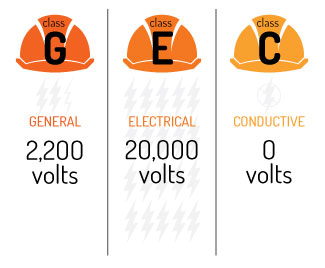Some people may wonder if carpenters need to wear hard hats. It actually depends on the type of work that they are engaged in.
If they work at a construction site, the answer is probably a resounding yes! The Occupational Safety and Health Administration guidelines state
“Employees working in areas where there is a possible danger of head injury from impact, or from falling or flying objects, or from electrical shock or burns, shall be protected by protective helmets.”
So, if a carpenter is not exposed to possible injuries of the head, head protective gear would not be required by OSHA standards.
Everything will depend on the type of task a carpenter is involved in and if there is work being done overhead where tools, objects, or debris can fall from above causing a head injury.
Building and construction sites can be incredibly dangerous, exposing workers to numerous hazards if there are no safety protocols in place. If there is even the slightest risk of a head injury, head protection should be used.
Comparison of Top Carpenter Hard Hats
| Hard Hat | Type and Class | Material | Accessories | Suspension |
|---|---|---|---|---|
| Neiko 53880A 5-in-1 | ANSI S12.42/S3.19 standard | ABS | 2 visors earmuffs | Ratchet suspension system |
| Centurion Vision Plus | Type 1 Class E | ABS | Integrated Visor | Ratchet suspension system |
| Husqvarna 592752601 | Type 1 Class E | High Density, Polyethylene, HDPE | Visor, earmuffs, Rain shield, Rain neck flap | Six-point ratchet system |
| Klein Tools #60407 Full Brim | Type 1 Class C | ABS | Light, Accessory slots, For easy accessory attachment | Ratchet suspension system |
| Acerpal Ridgeline ABS | Type 1 Classes G, E, and C | ABS | Accessory slots, For easy accessory attachment | Six-point ratchet system |
| ERB 19262 19762 Americana | Type 1 Classes G, E, and C | Polyethylene | Accessory slots, For easy accessory attachment | Four-point ratchet system |
Our List of Best Carpenter Hard Hats
1. Neiko 53880A 5-in-1 Hard Hat with Multiple Accessories
- Meets all ANSI standards and is CE approved for highest quality, safety, and performance
- Provides maximum face and hearing safety for forestry, construction, and other industrial work such as chainsaw operation protection
- Dial knob makes it easy to adjust fit and size of helmet for all head shapes
- 5-in-1 design with helmet, removable ear muffs, steel mesh visor, polycarbonate visor, and adjustable dial knob
Prices pulled from the Amazon Product Advertising API on:
Product prices and availability are accurate as of the date/time indicated and are subject to change. Any price and availability information displayed on [relevant Amazon Site(s), as applicable] at the time of purchase will apply to the purchase of this product.
This Neiko Hard Hat actually can fall into the Forestry Safety category. However, it shares many of the same concerns that carpenters at large industrial or construction sites might have.
Normally, the forestry category will provide both visor and earmuff accessories because these professionals use chainsaws on a daily basis, meaning lots of flying dust and woodchips as well as noise. This affordable hard hat comes with a foam headband, cushion earmuffs, and a soft lining in plastic.
The 5in1 design features two types of visor: polycarbonate or steel mesh, removable earmuffs with a Noise Reduction Rating of 22 dB great for chainsaws or demolition hammers. It has a ratchet suspension system that even allows the wearing of eyeglasses on the job.
Pros
-
-
- Two protective visors
- Ratchet suspension system
- Earmuffs with 22dB protection
- Meets all ANSI standards
- CE EN352-3 approval for quality and safety
-
Cons
-
-
- Poor assembly instructions included
-
2. Centurion Vision Plus Hard Hat
- Extremely Light ABS (Acrylonitrile Butadiene Styrene) Material. Starting at only 17 ounces
- Retractable Safety Visor
- Meets ANSI standards for head protection (Z89.1-2009 Class E-20,000V)
- Premium Absorbent Dry-Tech Sweatband
Prices pulled from the Amazon Product Advertising API on:
Product prices and availability are accurate as of the date/time indicated and are subject to change. Any price and availability information displayed on [relevant Amazon Site(s), as applicable] at the time of purchase will apply to the purchase of this product.
The Centurion Vision Plus Hard Hat is noteworthy for how lightweight it is starting at 17 ounces.
Made from durable and resistant ABS, it features a ratchet suspension system and an integrated visor that is retractable protecting carpenters from flying dust.
This visor also easily fits over prescription eyeglasses, so you’ll have no vision worries while on site.
It meets ANSI standards and comes with an absorbent sweatband. Replacement parts are also available. The Centurion Hard Hat is Type 1, Class E.
Pros
-
-
- Integrated Visor
- Ratchet suspension system
- ABS durability
- Lightweight
-
Cons
-
-
- Scratching on visor reported during use
-
3. Husqvarna 592752601 Hard Hat with accessories
- UV protected Orange hard hat - one size fits most
- Adjustable 6-point suspension system and slip ratchet adjustment
- Includes: face visor, 25 db (a) NRR hearing protectors, rain shield and rain neck protector
- Meets and exceeds isea/ ANSI Z89.1-2014 type I with electrical insulation - rated to class E
Prices pulled from the Amazon Product Advertising API on:
Product prices and availability are accurate as of the date/time indicated and are subject to change. Any price and availability information displayed on [relevant Amazon Site(s), as applicable] at the time of purchase will apply to the purchase of this product.
The Husqvarna 592752601 hard hat again falls into the forestry protection category because it is designed for professionals who operate chainsaws.
It offers great protection especially for carpenters who may find themselves working outside in the elements.
Accessories include a visor, NRR 25dB hearing protection earmuffs, and both a rain shield and rain neck protector flap.
There is a cotton sweatband on this Type 1, class E hard hat made in HDPE. The suspension system is a six-point ratchet.
Pros
-
-
- Useful accessories
- Durable
- Ratchet suspension system
-
Cons
-
-
- Some difficulty installing face screen reported
-
4. Klein Tools #60407 Full Brim Hard Hat
- Breathable, padded sweat-wicking sweatband and top pad improve comfort and are machine washable
- Adjustable vents can be opened or closed for maximum air circulation while meeting stringent safety standards
- Unique suspension system features a flexible open frame design to provide optimal fit and improved air circulation
- Class C, Type 1 hard hat with adjustable vents meets ANSI Z89.1-2014, CSA Z94.1-15; EN397:2012+A1:2012-5.2.4 (Lateral Deformation-LD); EN12492:2012-4.2.1.2, 4.2.1.3, 4.2.1.4 (Front/Back/Side impact)
Prices pulled from the Amazon Product Advertising API on:
Product prices and availability are accurate as of the date/time indicated and are subject to change. Any price and availability information displayed on [relevant Amazon Site(s), as applicable] at the time of purchase will apply to the purchase of this product.
This hard hat is a full brim protective hat with ventilation and light for carpenters who work inside and need direct illumination at their workstation.
It features a slot on the front of the cap to mount a light. The lamp provided is wireless and rechargeable, meaning no purchasing of batteries.
The hat features vents that can be opened or closed for air circulation. The hat shell is manufactured in polycarbonate ABS acrylonitrile butadiene styrene making it tough and resistant.
It features inner padding that is washable and universal accessory slots for carpenters who desire increased protection. The lining contributes to comfort.
This Klein hat boasts a ratchet suspension system with a dial for size adjustment. It is compliant with ANSI safety standards Type 1, Class C.
Pros
-
-
- Comes with a hard hat light
- Comfortable and breathable
- Padded
- Washable sweatbands
- Ratchet suspension system
-
Cons
-
-
- A bit heavy
- Sizing considerations
-
5. Acerpal Ridgeline ABS Hard Hat with 6-point suspension
- GET IN THE GROOVE
- RELIABLE PROTECTION
- SECURE COMFORTABLE FIT
- Fully compliant with OSHA, ANSI Z89.1-2014, Cert. Mod. - CAN/CSA Z94.1-15, Type 1, Class E, G, and C standards.
Prices pulled from the Amazon Product Advertising API on:
Product prices and availability are accurate as of the date/time indicated and are subject to change. Any price and availability information displayed on [relevant Amazon Site(s), as applicable] at the time of purchase will apply to the purchase of this product.
This full brim hard hat made in durable ABS gives superb safety coverage. Lightweight, it offers a six-point ratchet suspension system that is padded permitting all-day wear without problems.
This cap also allows for accessories like earmuffs or other customized preferences. Type 1, Classes G, E, and C. This is a good hard hat that allows you to select and attach your preferred safety accessories.
Pros
-
-
- Durable ABS
- Ratchet suspension system
- Lightweight
- Universal slots for accessory attachment
-
Cons
-
-
- Color or design fading with sun exposure
-
6. ERB 19262 19762 Americana Hard Hat
- High density polyethylene
- Provides protection from sun and rain
- 4-Point nylon
- Accessory slots accommodate a variety of eye, face, and hearing products
- Adjusts to head sizes 6.5-9
Prices pulled from the Amazon Product Advertising API on:
Product prices and availability are accurate as of the date/time indicated and are subject to change. Any price and availability information displayed on [relevant Amazon Site(s), as applicable] at the time of purchase will apply to the purchase of this product.
This Cap style of the hard hat is a great budget choice. Manufactured in high-density Polyethylene it protects from the sun and elements and boasts a 4-point ratchet suspension system.
The accessory slots on the hat permit customized accessories for eyes, face, and hearing protection making it a great choice for carpenters.
Made in the USA, it is type 1 and meets safety standards for classes G, E, and C. It also comes with a chin strap and a six-month warranty.
Pros
-
-
- High-density polyethylene
- Ratchet suspension system
- Removable moisture wick brow pad
- Budget buy
-
Cons
-
-
- Overly large sizing reported
-
Great and Necessary Gear for your Head Protection
Some very common types of head protection gear used at a construction or building site include
-
-
- Bump Caps are very lightweight helmets that can protect workers from minor bumps to the head. These caps are ideal where it’s a good idea to wear a hard hat or helmet, but it isn’t necessarily required.
- Hard Hats are ideal for head protection in very dangerous work environments.
- Ear Protection is for work environments where exceptionally loud noise can do permanent damage to a worker’s hearing.
- Face Shields are used to protect the face from dust, debris, chemicals, or dangerous liquids.
- Safety glasses can be used to protect the eyes from dust or liquid splash.
-
Types for Classifying Hard Hats
Hard hats come in two types.
-
-
- Type 1 protects workers from objects, debris, or tools that strike the worker from above.
- Type 2, often referred to as “side impact” hard hats, will protect workers from lateral blows to the head and from blows to the top of the head.
-
What Class of Hard Hat do I Need for my Profession?
Hard hats are classified into three different classes.

-
-
- Class C hard hats are conductive helmets that offer no protection from electrical hazards.
- Class E hard hats are designed to protect electricians and workers in high voltage environments and against electrical currents up to 20,000 volts.
- Class G hard hats are considered “general” hard hats that offer hard hat protection in areas exposed to very low -voltage electrical current up to 2200 volts.
-
Colorful Hard Hats for On-the-job Identification and Visibility
This will often depend on the employer. Many companies assign specific hard hat colors to specific squads of professionals.
For example, a white hard hat is often worn by management or engineers. Blue hard hats may be worn by carpenters, technicians, or even electricians.
If you plan on purchasing a personal hard hat, check with your employer to see if a specific color is assigned to professional carpenters on site.
How Should I Choose my Hard Hat When Purchasing?
First of all, consider your profession or trade. Evaluate any risks that you may encounter in your work environment. For a carpenter, this may mean
-
-
- Chemicals such as paints, solvents, or stains used on site
- Collapsing roofing or wood beams
- Hanging exposed electrical wires and electricity surges
- Loud noise from tools and machinery
- Using tools and machinery such as powered saws, nail guns, or sanders
- Wood dusts and wood chips
-
Carpenters work both outdoors and indoors on numerous types of construction projects. Whether installing wall and roof framing or kitchen cabinets, they will work in the most varied conditions and in all types of positions requiring PPE.
Choose the best type and class and any necessary safety features. Ask your employer or supervisor if they prefer a particular type and color of the hard hat as protective gear. Consider fit.
The correct fit not only guarantees your safety but your comfort as well. You may also require more than one hard hat on the job depending on what you are involved in.
Your hard hat should not only protect your head but be comfortable to wear all day long. Sometimes wearing a liner will increase comfort but a good suspension system can make all the difference.
See also: The Best hard hat for large size head
Hard Hat Basics for Choosing and Buying Wisely
Most hard hats will be manufactured in high-density polyethylene however you may find a hard hat that you like in polycarbonate, aluminum, or fiberglass also. Polyethylene is used for making tons of things including bottles and even bulletproof vests.
A hard hat has fundamentally two parts
-
-
- The outer hard shell
- The interior suspension system made from nylon, polyethylene, or vinyl
-
Hard hats are designed and manufactured to absorb the force of any impact and spread the blow of the impact evenly dissipating its strength.
While the outer hard shell will deflect the impact, the strength of the blow will be dispersed thanks to the interior suspension system.
Since the suspension system keeps the hard shell from touching the wearer’s head, the blow will not be absorbed by the skull, but rather by the hard hat.
The suspension system’s purpose is also to ensure the correct fit for your head and should provide space between your head and your helmet, from approximately 30 mm. to 1.2 inches.
The type you pick will depend on your own personal preference, however, the hard hat must fit correctly to impede any impact force from directly reaching your head. Types of mechanisms include:
-
-
- Pin-lock
- Ratchet
- Swing rachet
- Touch
-
Suspension bands will normally be manufactured in nylon or polyester. Some helmets will offer extra cushioning in polystyrene foam that will be positioned between the helmet and the suspension bands.
Hard hats may come with two, four, or six suspension points. A point suspension system will help to spread the weight more evenly on your head, increasing comfort, as well as the impact from falling debris, will be more evenly distributed.
See also: Do Carpenters Need Steel Toe Boots?
Our Final Considerations
As a professional carpenter, you need great personal protective equipment for your personal safety.
Together with safety glasses or a face shield, gloves, and ear protection, you will need the best carpenter hard hat that you can find and that your wallet can afford.
This hard hat may save your life or your health. Make the best possible investment your budget will allow.
Inspect your hard hat daily, making sure to check out the outer shell and the suspension system. If you suspect that the hard hat has been compromised in any way, replace it immediately before returning to your work site.
Remember to check the manufacturer’s date on the hard hat that you purchase to get the five years of service from this piece of gear. We hope this article will help you find the best carpenter hard hat for your personal protection on the job.







